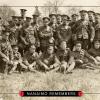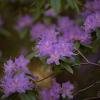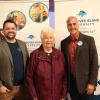November 5, 2010 - 9:27am
Curious members of the public will have a unique opportunity to see salmon spawning in the city.
A record number of coho are expected to travel up the 14-kilometre Millstone River through Bowen Park in Nanaimo this month.
“It’s the perfect outdoor classroom for the public and students,” said John Morgan, Professor of Fisheries Management in the Resource Management Officer Technology (RMOT) program at Vancouver Island University (VIU). “We’re expecting a large run – perhaps as many as 500 adult coho.”
Students will assist Department of Fisheries and Oceans (DFO) staff in tracking and monitoring the migrating coho, identifying spawning grounds and assessing areas for in-stream habitat conditions and opportunities for habitat protection and future restoration.
“The focus of the RMOT program is to educate students in the area of natural resource management and protection,” said Morgan. “This project provides an excellent opportunity for experiential learning in salmon biology and management.”
For over 40 years, DFO and local stewardship groups have been working to make the Millstone River accessible to coho salmon. VIU faculty and students got involved several years ago, and are assisting with a long-term goal to establish a self-sustaining run of coho in the river.
Stepping pools (known as “the staircase”) were created in the lower Millstone in the early 1980s to allow fish to move up a rock face. A fish ladder was constructed at a waterfall in Bowen Park but coho were unable to make it over the second falls further upstream.
Coho fry and adults from the Nanaimo River Hatchery were introduced into the upper watershed; and returning adults were trapped and released above the barriers. But the effort is not sustainable in the long term because it is labour intensive and costly, said Morgan.
Thanks to a partnership project between the DFO, VIU , City of Nanaimo, and a host of other environmental stewardship groups including the Nanaimo Fish and Game Club, Island Waters Fly Fishers (IWFF) and Friends of the Millstone, an 800-metre side-channel around the falls was completed in October 2007.
This has allowed returning coho adults to migrate into the upper watershed on their own for the first time and access to suitable spawning and rearing areas in the upper Millstone watershed.
A motion sensitive camera was installed in the fishway in the upper end of the channel in 2009 to record adult coho salmon passing through the channel and into the upper Millstone watershed. The footage is monitored by VIU’s RMOT students.
Coho and other fish species such as Chinook salmon, cutthroat trout, lamprey, sunfish and stickleback, were observed moving both upstream and downstream past the video camera, indicating the side-channel is well used by several fish species, said Morgan.
“In fact, monitoring studies of coho fry rearing and smolt outmigration indicate the upper Millstone watershed provides very productive habitat for coho salmon,” said Morgan. “It has been estimated that a self-sustaining run of coho in the upper watershed could produce 30,000 smolts, similar to the well-known Englishman River in Parksville.”
Coho returning to the Millstone River this fall will be captured in the fishway near the upper end of the side-channel, inserted with radio-transmitters by RMOT students and manually tracked throughout the watershed to locate their spawning grounds. Funding and tags for the radio-telemetry project has been provided by DFO, IWFF and BC Hydro.
The spawners are difficult to see because they tend to hide during the day and travel at night. “The coho may spawn during high water, turbid conditions,” said Morgan. “They also prefer to spawn in small tributary streams which can be difficult to locate in a large watershed such as Millstone.
“The radio transmitters will allow us to locate their spawning locations more precisely. It’s a common technique used in fish passage and migration studies.”
The Millstone River side-channel initiative has already provided significant ecosystem, educational, economic and community benefits, Morgan said. Eventually, increasing coho salmon runs in the Millstone is expected to enhance the local sports fishery, similar to what has been observed recently with the restoration of pink salmon to the Nanaimo area and other locations along the east coast of Vancouver Island.
To celebrate the Millstone restoration work, the City of Nanaimo is hosting a “Salute to the Coho” event Saturday, Nov. 20 from 10 to 1 pm at Bowen Park’s Amphitheatre. Activities will include fish-tagging demonstrations, interpretive walks along the Millstone River, a poetry reading, and an interactive model of the lifecycle of a salmon.
Tags: In the Community






